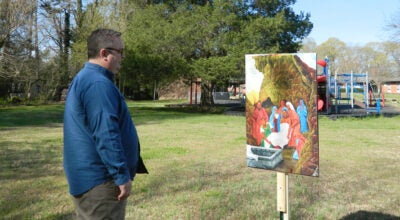Memories of the Old Stone House
Published 12:00 am Monday, September 29, 2014
My family and I recently attended the Old Stone House Germanfest for the third year in a row, also my third year of singing a short program of German songs there.
Kaye Brown (Braun) Hirst and her docents brought back the times of Michael Braun through living demonstrations and the house tour.
Two sweet young girls patiently advised my candle-making efforts. Their period dress predated Laura Ingalls Wilder’s memories by a century. While dipping the string into the wax, my mind temporarily misplaced the 21st century, including Germanfest’s patrons’ parked cars along the Old Stone House Road.
I could imagine those girls as spirits of some the Brauns buried in the shadowy family cemetery across the road, their ghosts returning to add a few earthly hours to lives cut short before the advent of modern medicine.
Thinking of “other things Braun” (excepting the late rocket scientist):
A certain Granite Quarry teacher with the last name “Brown” always displayed a sweet smile. While not my teacher, she fell under the categories: “teacher in the hall,” “teacher in the cafeteria,” “teacher in the auditorium,” and “teacher on the bus lot.”
“Brown Supply Company.”
Back to the “crux”: our classes toured the Old Stone House back then (early 1960s).
In addition to rooms and their furnishings, I was especially fascinated by that place in the floor above which curing hams had been hung. The dripping, salty fat permeated the wood, and during temporary times of the house’s abandonment, deer and other animals had licked the salty floor, causing “dimples,” as if the wood were having a problem with cellulite (also fat related).
There may be pig DNA soaked into that floor, but no need to “Jurassic Park” those particular pigs, since pigs as a species still exist, especially at places such as Winks, Richard’s, College, Hendrix, Johnson’s, etc.
Today’s tours are fact-based, but back then, we sometimes heard some strange stuff.
Someone told us the upstairs ventilation openings were “gun ports” in the event of an Indian attack.
I remember them as not having much leeway for a musket to be angled downward, so the Indian would have had to have conveniently climbed an opposite tree to the place “just right” ( “Goldilocks”) to be shot.
Such “accommodation” reminds me of the old TV show “Combat.” Even if covered and secure, it was only a matter of time before the German jumped up for the express purpose of gleefully (well, maybe not “gleefully”) being shot dead by Vic Morrow, Rick Jason and company.
Someone told us of a “sabre” cut in the house made by a British officer on horseback. Supposedly, he galloped straight through, both front and back doors being conveniently left open.
If only he had carved some Ancestry.com-traceable initials! The close quarters there lead me to believe that any such ride would have been disastrous for both rider and horse, possibly necessitating the “coup de grace” for both.
The Old Stone House never needed fiction for enhancement. It is justly served by truths told by my brother Joe and the other docents there.
The story of Michael Braun, his house’s construction and later travails before restoration trump the imagined. In fact, at one sad point, cows and other animals walked in places where the visiting public walks today!
Instead of the fantastic, I would rather ponder the existence of creasy greens in the Old Stone House’s back yard in the early 1970s.
That ’70s weekend, I toured the Old Stone House with the late Esther Rufty Hodgin (one of this world’s sweeter souls, a ranking surely transferred to Heaven, where she now rates as one of the sweeter souls there).
When we exited the back door, Esther cried “Creasy greens!” and they truly were, matching the picture on cans back then, labeled “Land Cress.”
We wondered if they had spread from the old Braun family garden, but they probably just grew wild.
World War I soldiers from Patrick County, Virginia carried into battle the naturally twinned crystals of the mineral “staurolite,” sometimes forming the right-angled Christian cross. They were kept close, in a “heart-proximity” pocket for good luck. These “oddities” of the natural world are called “Fairy Crosses” or “Fairy Stones.”
People native to eastern Rowan County carry the memory of a whole “house of stones” throughout their lives; and being a mental image, it isn’t limited to the containment of a heart-placed pocket.
It is kept even closer, dearer, within the recesses of the heart itself.


